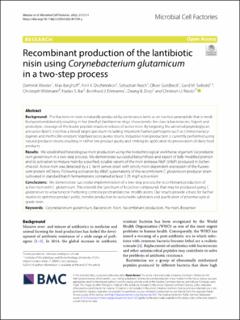| dc.contributor.author | Weixler, D. | |
| dc.contributor.author | Berghoff, M | |
| dc.contributor.author | Ovchinnikov, Kirill | |
| dc.contributor.author | Reich, Sebastian | |
| dc.contributor.author | Goldbeck, Oliver | |
| dc.contributor.author | Seibold, Gerd M. | |
| dc.contributor.author | Wittmann, Christoph | |
| dc.contributor.author | Bar, Nadav S | |
| dc.contributor.author | Eikmanns, Bernhard J | |
| dc.contributor.author | Diep, Dzung B. | |
| dc.contributor.author | Riedel, Christian U. | |
| dc.date.accessioned | 2023-01-31T15:18:26Z | |
| dc.date.available | 2023-01-31T15:18:26Z | |
| dc.date.created | 2022-01-21T14:17:01Z | |
| dc.date.issued | 2022 | |
| dc.identifier.issn | 1475-2859 | |
| dc.identifier.uri | https://hdl.handle.net/11250/3047488 | |
| dc.description.abstract | Background
The bacteriocin nisin is naturally produced by Lactococcus lactis as an inactive prepeptide that is modified posttranslationally resulting in five (methyl-)lanthionine rings characteristic for class Ia bacteriocins. Export and proteolytic cleavage of the leader peptide results in release of active nisin. By targeting the universal peptidoglycan precursor lipid II, nisin has a broad target spectrum including important human pathogens such as Listeria monocytogenes and methicillin-resistant Staphylococcus aureus strains. Industrial nisin production is currently performed using natural producer strains resulting in rather low product purity and limiting its application to preservation of dairy food products.
Results
We established heterologous nisin production using the biotechnological workhorse organism Corynebacterium glutamicum in a two-step process. We demonstrate successful biosynthesis and export of fully modified prenisin and its activation to mature nisin by a purified, soluble variant of the nisin protease NisP (sNisP) produced in Escherichia coli. Active nisin was detected by a L. lactis sensor strain with strictly nisin-dependent expression of the fluorescent protein mCherry. Following activation by sNisP, supernatants of the recombinant C. glutamicum producer strain cultivated in standard batch fermentations contained at least 1.25 mg/l active nisin.
Conclusions
We demonstrate successful implementation of a two-step process for recombinant production of active nisin with C. glutamicum. This extends the spectrum of bioactive compounds that may be produced using C. glutamicum to a bacteriocin harboring complex posttranslational modifications. Our results provide a basis for further studies to optimize product yields, transfer production to sustainable substrates and purification of pharmaceutical grade nisin. | en_US |
| dc.language.iso | eng | en_US |
| dc.publisher | BMC | en_US |
| dc.rights | Navngivelse 4.0 Internasjonal | * |
| dc.rights.uri | http://creativecommons.org/licenses/by/4.0/deed.no | * |
| dc.title | Recombinant production of the lantibiotic nisin using Corynebacterium glutamicum in a two-step process | en_US |
| dc.title.alternative | Recombinant production of the lantibiotic nisin using Corynebacterium glutamicum in a two-step process | en_US |
| dc.type | Peer reviewed | en_US |
| dc.type | Journal article | en_US |
| dc.description.version | publishedVersion | en_US |
| dc.source.volume | 21 | en_US |
| dc.source.journal | Microbial Cell Factories | en_US |
| dc.source.issue | 11 | en_US |
| dc.identifier.doi | 10.1186/s12934-022-01739-y | |
| dc.identifier.cristin | 1987456 | |
| cristin.ispublished | true | |
| cristin.fulltext | original | |
| cristin.qualitycode | 1 | |

